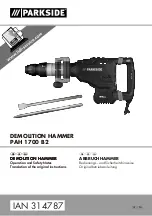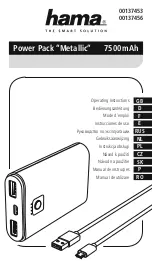
3
Operating Instructions and Parts Manual
26038
7/21
2021 OEMTOOLS
®
AIR BLOW AND
SUCTION GUN
SPECIFIC SAFETY INSTRUCTIONS
AND WARNINGS
WARNING
FAILURE TO OBSERVE THESE WARNINGS COULD
RESULT IN INJURY. This instruction manual contains important safety
information. Read this instruction manual carefully and understand all
information before operating this tool.
Some dust created by power sanding, sawing, grinding, drilling, and
other construction activities contains chemicals known to cause
cancer, birth defects or other reproductive harm. Some examples of
these chemicals are:
• lead from lead-based paints
• crystalline silica from bricks and cement and other masonry
products
• arsenic and chromium from chemically-treated lumber
Your risk from these exposures varies, depending on how often you
do this type of work. To reduce your exposure to these chemicals,
work in a well ventilated area and work with approved safety
equipment, such as those dust masks that are specially designed to
filter out microscopic particles.
WARNINGS
1. Always operate, inspect and maintain this tool in accordance with
American National Standards Institute Safety Code of Portable Air
Tools (ANSIB186.1) and any other applicable safety codes and
regulations.
2. For safety, top performance and maximum durability of parts,
operate this tool at 90 psig; 6.2 bar max air pressure with 5/16"
diameter air supply hose.
3. Always wear impact-resistant eye and face protection when
operating or performing maintenance on this tool. Always wear
hearing protection when using this tool.
4. High sound levels can cause permanent hearing loss. Use
hearing protection as recommended by your employer or OSHA
regulation.
5. Keep the tool in efficient operating condition.
6. Operators and maintenance personnel must be physically able to
handle the bulk, weight and power of this tool.
7. Air under pressure can cause severe injury. Never direct air at
yourself or others. Always turn off the air supply, drain hose of
air pressure and detach tool from air supply before installing,
removing or adjusting any accessory on this tool, or before
performing any maintenance on this tool. Failure to do so could
result in injury. Whip hoses can cause serious injury. Always
check for damaged, frayed or loose hoses and fittings, and
replace immediately. DO NOT use quick detach couplings at tool.
See instructions for correct set-up.
8. Air powered tools can vibrate during use. Vibration, repetitive
motions or uncomfortable positions over extended periods of time
may be harmful to your hands and arms. Discontinue use of tool
if discomfort, tingling feeling or pain occurs. Seek medical advice
before resuming use.
9. Place the tool on the work before starting the tool.
10. DO NOT indulge in any horseplay with this tool.
11. Slipping, tripping and/or falling while operating air tools can be a
major cause of serious injury or death. Be aware of excess hose
left on the walking or work surface.
12. Keep body working stance balanced and firm. DO NOT over reach
when operating the tool.
13. Anticipate and be alert for sudden changes in motion during start
up and operation of any power tool.
14. DO NOT carry tool by the hose. Protect the hose from sharp
objects and heat.
15. Tool shaft may continue to rotate briefly after throttle is released.
Avoid direct contact with accessories during and after use. Gloves
will reduce the risk of cuts or burns.
16. Keep away from rotating end of tool. DO NOT wear jewelry or
loose clothing. Secure long hair. Scalping can occur if hair is not
kept away from tool and accessories. Choking can occur if neck
wear is not kept away from tool and accessories.
17. DO NOT use near flammable material, such as gas tanks.
18. DO NOT vacuum any liquids.
19. Take care that the exhaust air does not point towards any other
person or material or substance that could be contaminated by oil
droplets. When first lubricating a tool or if the tool exhaust has a
high oil content DO NOT allow the exhaust air to come near very
hot surfaces or flames.
20. This tool is not suitable for underwater use or use in explosive
environments.
21. DO NOT lubricate tools with flammable or volatile liquids such as
kerosene, diesel or jet fuel.
22. DO NOT remove any labels. Replace any damaged labels.
23. Use accessories recommended by OEMTOOLS
®.
OPERATION INSTRUCTIONS
CAUTION
:
To operate as a blow gun, remove end cap, remove
and reverse the position of the valve. Always ensure that the o-rings
are replaced properly.
Factors outside the tool may cause loss of power or erratic action.
Reduced compressor output, excessive drain on the air line, moisture
or restrictions in air pipes or the use of hose connections of improper
size or poor condition may reduce air supply. Grit or gum deposits
in the tool may cut power and may be corrected by cleaning the air
strainer and flushing out the tool with gum solvent oil or an equal
mixture of SAE #10 oil and kerosene. If outside conditions are in order
and the tool continues erratic action or low power, disconnect tool
from hose and take tool to your nearest authorized service center.
AIR SUPPLY
Tools of this class operate on a wide range of air pressures. It is
recommended that air pressure of these tools measures 90 psi at the
tool while running free. Higher pressure (over 90 psig; 6.2 bar) raises
performance beyond the rated capacity of the tool, which will shorten
tool life because of faster wear and could cause injury.
Always use clean, dry air. Dust, corrosive fumes and/or water in
the air line will cause damage to the tool. Drain the air tank daily.
Clean the air inlet filter screen on at least a weekly schedule. The
recommended hookup procedure can be viewed in the below figure.
The air inlet used for connecting air supply has standard 1/4" NPT. Line
pressure should be increased to compensate for unusually long air
hoses (over 25 feet). Minimum hose diameter should be 5/16" I.D. and
fittings should have the same inside dimensions and be tightly secured.
Drain Daily
Regulator
Oiler
Quick Coupler
Leader
Hose
Nipple
Do Not Install
Quick Coupling
Here
Nipple
Filter
Air Supply
Whip Hose






















